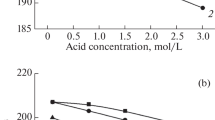Abstract
Activated carbon can be used as collector material in trace analysis. Due to the special character of activated carbon, not only unsoluble compounds can be enriched, but also many soluble chelate complexes of trace elements. For that purpose the buffered aqueous solution of the analytical sample containing complexing or precipitating reagents is filtered through a small filter paper covered with 50 mg of activated carbon. The trace compounds, and in many cases also the surplus reagent are adsorbed by the collector.
By treating the carbon collector with acid after the process of trace enrichment, a trace concentrate free of unwanted substances is obtained. Thus it is possible to use sensitive electrochemical and optical methods for the determination. For the determination of the enriched elements by atomic absorption spectrometry, the activated carbon suspended in diluted nitric acid can be dispersed directly into the atomizer. The carbon particles do not cause any interferences.
The application and the advantages of activated carbon for enrichment of trace elements in high-purity materials is demonstrated by some analytical examples.
Zusammenfassung
Aktivkohle kann als Spurenfänger bei Anreicherungsprozessen verwendet werden. Wegen der besonderen Adsorptionseigenschaften der Aktivkohle können dabei nicht nur unlösliche Verbindungen angereichert werden, sondern es werden in vielen Fällen auch leichtlösliche Chelatkomplexe der Spurenelemente an der Kohleoberfläche adsorbiert. Zur Spurenanreicherung genügt es, die mit einem fällenden oder komplexierenden Reagens versetzte Probenlösung durch ein mit 50 mg Aktivkohle beschichtetes kleines Filterpapier zu filtrieren. Dabei bleiben die Spurenverbindungen und in manchen Fällen auch das überschüssig verwendete Reagens am Spurenfänger haften.
Man erhält ein von störenden Fremdstoffen freies Spurenkonzentrat, wenn man die Aktivkohle nach der Spurenanreicherung mit Säure behandelt. Dadurch können für die Bestimmung der Spuren auch empfindliche elektrochemische und optische Verfahren eingesetzt werden. Zur atomabsorptions-spektrometrischen Bestimmung der angereicherten Elemente kann die in verdünnter Salpetersäure suspendierte Aktivkohle unmittelbar zerstäubt werden. Die Kohlepartikel verursachen keine Störungen.
Anwendung und Vorteile von Aktivkohle als Spurenfänger zur Analyse von Reinststoffen werden anhand einiger Analysenbeispiele demonstriert.
Similar content being viewed by others
Literatur
Bartell, F. E., Miller, E. J.: J. Am. Chem. Soc. 44, 1866 (1922).
Bouberlová-Kosinová, L.: Collect. Czech. Chem. Commun. 35, 1464 (1971).
Deutsches Arzneibuch, 6. Aufl. 1926. Stuttgart: Deutscher Apothekerverlag, Neudruck 1951.
Jackwerth, E., Graffmann, G., Lohmar, J.: diese Z. 247, 149 (1969).
Koch, O. G., Koch-Dedic, G. H.: Handbuch der Spurenanalyse. Berlin-Göttingen-Heidelberg-New York: Springer 1964.
Manova, T. G., Raginskaya, L. K., Pevtsov, G. A., Pavlova, L. A.: Trudy Vses. Nauch.-Issl. Inst. Chim. Reakt. 1970, 137; vgl. Anal. Abstr. 23, 109 (1972).
Mattson, J. S., Mark, H. B., Jr.: Acivated carbon. New York: M. Dekker Inc. 1971.
Pohl, F. A.: diese Z. 142, 19 (1954).
Robinson, J. W., Lott, P. F., Barnard, A. J., Jr.: The application of chelates to flame analytical techniques. In: H. A. Flaschka and A. J. Barnard, Jr.: Chelates in analytical chemistry, Vol. 4. New York: M. Dekker Inc. 1972.
Rush, R. M., Yoe, J. H.: Anal. Chem. 26, 1345 (1954).
Sandoz, D. P., Murray, D. L.: Varian-Techtron Resonance Lines 2, Nr. 1, 7 (1970).
Sigworth, E. A., Smith, S. B.: J. Am. Water Works Assoc. 64, 368 (1972).
Steeberg, B.: Adsorption and exchange of ions on activated charcoal. Uppsala: Almquist and Wiksells 1944.
Ullman Encyklopädie der technischen Chemie, Bd. 9. München-Berlin: Urban & Schwarzenberg 1957.
Author information
Authors and Affiliations
Additional information
Wir danken der Deutschen Forschungsgemeinschaft sowie dem Fonds der chemischen Industrie für die finanzielle Unterstützung dieser Arbeit.
Rights and permissions
About this article
Cite this article
Jackwerth, E., Lohmar, J. & Wittler, G. Über die Verwendung von Aktivkohle zur Anreicherung von Spurenelementen mit nachfolgender Bestimmung durch Atomabsorptions-Spektrometrie. Z. Anal. Chem. 266, 1–8 (1973). https://doi.org/10.1007/BF00424155
Published:
Issue Date:
DOI: https://doi.org/10.1007/BF00424155




